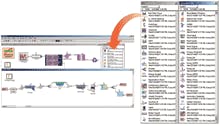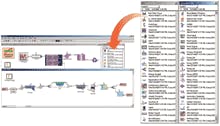by Cari K. Ishida, Elisa Garvey, Shawn Dent, and H. Stephen McDonald
Consuming up to 35% of the energy used by municipalities, water supply and wastewater treatment systems are among the most energy-intensive facilities owned and operated by local governments. Water agencies are increasingly challenged to manage their facilities and resources as efficiently as possible. Confounding this goal is managing the risks of rapidly changing regulatory demands, aging infrastructure needs, and other planning uncertainties. Rising construction costs are also a growing concern to many utilities.
It is essential for planning purposes to understand the sensitivity of systems to changing costs, such as energy costs. Typically, these uncertainties are addressed by incorporating redundancy and conservatism in the planning and design of new facilities, which increases cost. Instead, the best solution is to reduce risks through increased knowledge and forecasting capabilities.
Challenge
Most municipalities face similar questions when it comes to planning, operations, and engineering, such as:
- Planning: What new capital facilities are required and when are they needed?
- Operations: How to optimize existing capacity and minimize operations costs?
- Engineering: What new technologies are required to meet performance and/or cost requirements, and where in the system are they needed?
The challenge is addressing these questions in an integrated and comprehensive manner by integrating the data and knowledge held within multiple departments. Often, planning, operations, maintenance, engineering and finance departments each are consumed with their own individual missions such that coordination is difficult to achieve in making integrated capital and operations and maintenance (O&M) cost decisions that require an overall systems perspective. Therefore, an improved approach to facilitate the communication of logistical, physical, and technical information is required.
In addition, the difficulty of making integrated decisions regarding planning, operations, and engineering for water and wastewater facilities lies in the inherent complexity of these kinds of systems.
Modeling System
To address these challenges, Carollo Engineers created an integrated, computerized model to support comprehensive decision-making for water and wastewater utilities. It was essential that the model include all of the major components of the water system: facilities for collection, treatment, and distribution. To more accurately simulate complex water operations, a dynamic (versus steady-state or static) model was required. The result was an integrated tool called OptimoTM that facilitates the planning process for water utilities.
Optimo allows configuration of complex water and wastewater systems that may include conveyance systems, treatment processes, flow equalization/storage, and/or water distribution systems from a library of “blocks.”. The user connects these blocks (much as one would configure a flow chart or schematic) and inputs the desired operational parameters. The benefit of constructing a model of the system in this “drag and drop” fashion is that it is fast and easy to initially configure an existing (or proposed) combination of facilities.
The user may configure a “base case” and numerous scenarios for model test runs. A summary block displays key output data including total O&M and capital costs, processes with insufficient peak and average capacity, and satisfaction of water demands.
The model consists of three modules: 1) Input Data Module, 2) Calculation Module, and 3) Dashboard/Outputs Module. The overall model logic diagram includes a breakdown of the modules and the optimization “do loops.” The main “engine” of the model, also referred to as the calculation module, was custom programmed using an object-oriented software platform. The input and output modules were constructed in Excel.
Temporal scale is critical since it is directly related to the type of questions that need to be answered with the model. Temporal scales used in modeling can be divided into three main categories:
- Master planning: Typically based on 20-year forecasts, this scale partitions capital projects into yearly intervals.
- Tactical analyses: Also called permit compliance decisions, these are typically concerned with a monthly time scale down to a daily time scale.
- Operational alalyses: These examine decisions that are typically on less than a 24-hour time scale.
Optimo was constructed on an hourly time step to address these three decision types, and can run for a total duration of one year (8,760 hours). Three hourly input data sets include influent flow (diurnal flow patterns), water market demands, and power cost (which can fluctuate by time of day and season).
The calculations completed in Optimo are based upon fundamental engineering principles of conservation of mass, flow, and energy. The calculations are completed based on inputs including projected source water quality and quantity, water market demands, plant performance, and anticipated regulatory requirements. Operations costs are calculated based upon financial input data including labor and supply costs (including chemicals), and power costs (co-generation, natural gas power generation, and power purchased from the grid). Model outputs include total O&M expenditures, capacity exceedance, solids production rates, total power consumption, and market demand constraints.
The modeling system run options include scenario generation and optimization. For a single run or scenario, the user can compare new scenarios to a base case scenario. An optimization run employs a genetic algorithm optimization engine that automatically runs the model numerous times, varying key parameters to determine the optimal solution (e.g., lowest total cost of operation). Key parameters can include diversions and bypasses within or between treatment plants, and operation of storage basins in the collection system, at the treatment plant, or within the water system. Another important use of the optimizer is testing the sensitivity of key parameters, such as increasing energy costs, to assess how existing facilities can be more efficiently utilized or whether new facilities are needed (e.g., solar or wind turbines). The optimizer can also be configured to minimize energy/chemicals consumption or greenhouse gas emissions.
Model Applications
Inland Empire Utilities Agency (IEUA) owns and operates multiple wastewater treatment plants with different treatment capacities, process capabilities, and discharge/reuse alternatives. The IEUA system consists of liquid treatment at four reclamation plants and solids treatment at two facilities. Several of the plants are interconnected with the ability to divert wastewater and/or solids to other plants. Given the complexity and interdependent nature of IEUA’s facilities, determining the optimum set of operating conditions was challenging.
Optimo was applied to IEUA’s wastewater system to test scenarios from its short-term business plan for water reuse. The drag and drop capability of the model allowed for rapid construction of reuse projects in the model. IEUA used the optimization mode of the model to determine whether hourly reuse demands could be met under different flow scenarios.
The application of this model can help utilities answer some fundamental questions. The model’s greatest strengths include the rapid generation of “what if” scenarios and the ability to incorporate capacity, distribution, and regulatory constraints to determine ideal operating conditions at a minimum cost. Utilities can utilize both the scenario and optimization run modes to address some of the planning issues and challenges that they may encounter. For example, if the existing system cannot convey projected flows, the bottlenecks and additional required capacities for each scenario are identified by the model, raising a red flag to the user that capital improvements are required.
About the Authors: Cari Eshida, Elisa Garvey, and Shawn Dent are members of the model development team led by Steve McDonald, a partner of Carollo Engineers (Walnut Creek, CA; www.carollo.com).




